The Shire-Reeve [Sheriff]
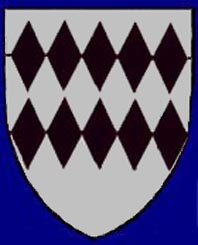 Henry de Faucumberg [Fauconberg,
Faucomberg, Falconberg, Fauconbridge &c.]
Henry de Faucumberg [Fauconberg,
Faucomberg, Falconberg, Fauconbridge &c.] Henry- born about 1275, was intermittently the Shire-Reeve of Nottingham from 1318 to 1330. He married Elena de Hertford daughter of Robert about 1292. One suggestion is that Henry's older brother, John de Faucumberg was disinherited by his father, William de Faucumberg of Catfoss (d. 4th February 1295) Holderness, East Riding of Yorkshire. This John has been presumed by Philips and Keatman to be "Little John". Thus Henry assumed control of the manor of Catfoss and and aquired the lands in Holderness on the 18th August 1295 including Barleburgh [Barlborough], Derbyshire and was "given" the manor and estate of Cukeneye [Cuckney] by John, his brother. In A Lytell Geste of Robyn Hode Little John is reported as hailing from Holderness, E. Riding. In 1297 Faucumberg was summoned to serve for The Hammer of Scotland, Edward I against the Scots. The arms of Sir Henry Fauconbridge are given by Foster are argent 10 lozenges (or fusils) conjoined 5, 5 barways sable (also described as argent 2 bars mascle sable). His brother William's arms were similar but the fusils were azure. Henry son of William of Catfoss' arms are also given as a fess between three crescents. Besides being conspicuously different these are entirely different from the arms of Walter de Faucumberg of Rise, Holderness who used or a fess azure in chief 3 palets gules. Walter's descendant family seem to have assumed the arms argent a lion rampant azure, from the Bruce arms of a predecessor, Peter de Brus of Skelton, Cleveland.11
Despite his lofty position
Henry seems to have had a fairly consistent criminal record:
| 8th December 1311 |
Charged with assault with his brother
John. |
| 12th March 1313 |
*Stole wood from Lord Warrenes barn. |
| 16th October 1313 | Pardoned for his part in the death of Edward II's friend, Piers Gaveston. |
| 13th October 1314 | *A fine for stealing wood. |
| 27th March 1315 | *Contempt of Court. |
| 18th October 1315 | *Fined for theft. |
* From the manor of Wakefield Court Rolls.
Subsequent to these miscreant deeds Henry at the age of twenty-three was appointed Sheriff of Nottinghamshire and Derbyshire on the 29th October 1318! This begs the question whether Henry de Faucumberg, the sheriff, and Henry de Faucumberg of the Wakefield Court Rolls were the same person. The conclusion seems more appropriate if they were not the same person. However, it was not unusual for persons to have been convicted of crimes to be appointed to official positions at this turbulent time.
.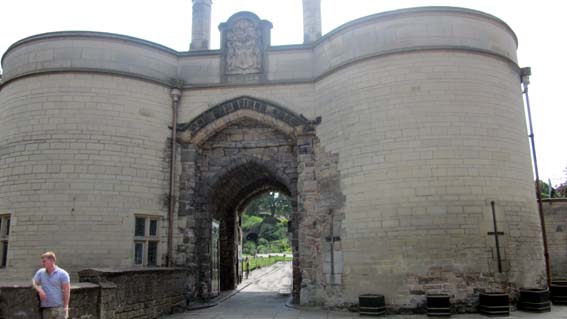
Drum towers to the gate house, outer curtain wall, Nottingham Castle
Henry's tenure as Sheriff of Notts. and Derbs. lasted initially until 5th November 1319 until again between 1st June 1323 to 20 October 1324 he assumed the office of sheriff. During this time Henry was made the Commander of Array for Yorkshire in July 1322 and served in King Edward II's army against the Scots in the second half of 1322 when Edward unsuccessfully entered Scotland ande retreated to Rievaulx Abbey in October where he was almost captured. Henry was made a knight for Yorkshire on the 30th May 1324 and a Sheriff of Yorkshire and Custodian of York Castle in October of the same year to Easter 1325. A list of sheriffs from Langdale's Yorkshire Dictionary also gives Hen. Falconberg as sheriff in 1329. This record also shows a John de Faucumberg [Joh.de Falconberg], perhaps his brother, was Sheriff for Yorkshire in 13424 The period from 1323 to 1327 was occupied by Roger de Somerville being the Sheriff for Yorkshire for 5 years during the aftermath of the turmoil in Yorkshire following Thomas Earl of Lancaster's uprising against King Edward II.
.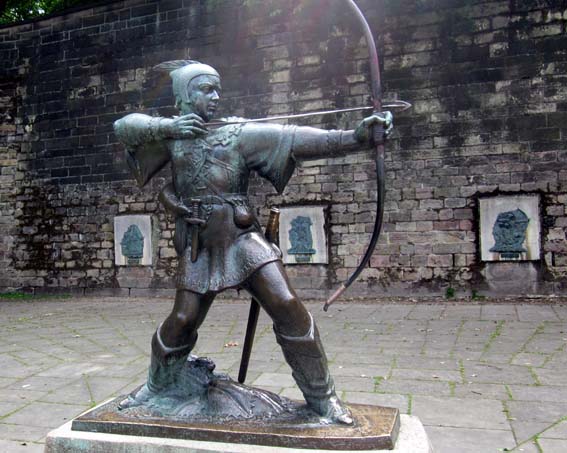
By 1327 the barons under Queen Isabella had overthrown Edward II. Edward III was crowned in the same year, whilst Edward II was placed in custody under Henry Plantagenet earl of Leicester (the late Thomas Earl of Lancaster's brother who later became the 3rd Earl of Lancaster). Edward II was incarcerated comfortably in Henry's castle at Kenilworth, Warwickshire. Two months later Edward was taken to Berkeley Castle near Bristol where he died, probably under tortuous conditions, popular stories relate by having a red-hot poker inserted in his rectum, leaving no obvious external evidence as to the cause of death.
.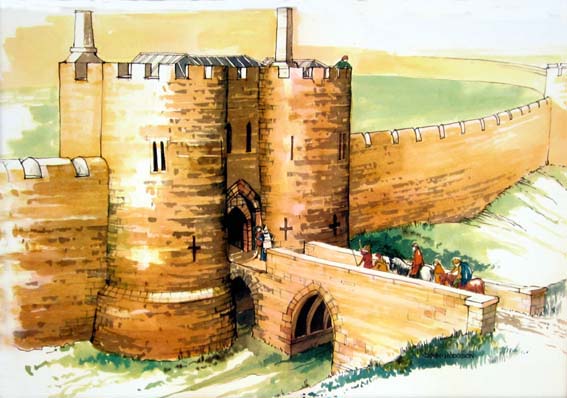
An artist's impression of the gatehouse entrance to Nottingham Castle - The wide dry moat was crossed by a a stone arched bridge parts of which still remain. Travellers then passed a drawbridge [not shown], iron portcullis and heavy wooden door through a long passage that could be closed off at each end. Originally an earth and timber structure [motte and bailey] was established here that was replaced by King Henry II in the late 1100's with a stone structure. This was to withstand a siege under the control of King Richard II during one of his rare stays in England. It is thought that there was at least one more storey to the gatehouse where men-at-arms were housed along with machines for working the portcullis and drawbridge. Considerable reconstruction of the upper parts of the gatehouse, outer bailey wall and bridge was undertaken in 1908
In 1315 the residents of Nottingham besieged the castle for eight days after the constable illegally imprisoned one of the towns folk.12 Following the disturbances of King Edward II's reign the castle was repaired and strengthened in the following reign when it became the prison for King David of Scotland who was kept in a cave beneath the castle in what is now called 'King David's Dungeon.
. 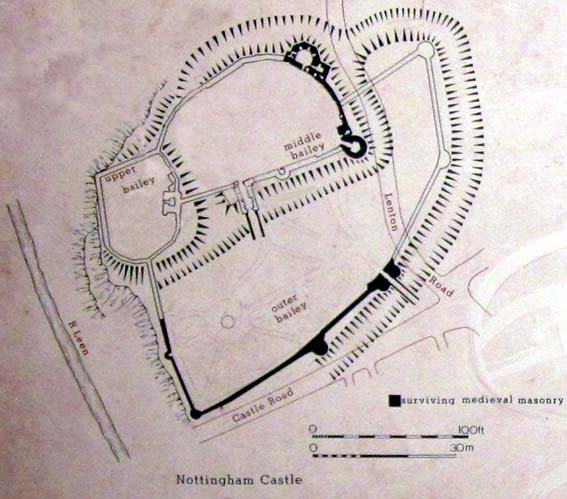
John de Eland
Later, in 1341, during Edward
III's reign, Sir John de Eland was made the sheriff for
Yorkshire. Sir William de Eland appears to have been
a brother to John. As the Deputy Constable of Nottingham
Castle in 1330, William de Eland, with Edward III burst
in on his the king's mother, Queen Isabella and her lover to seize
the crown. The ?brother, John De Eland, became the High Steward
to earl John de Warenne, Earl of Surrey who held the manor of Wakefield.
This steward as well as being a Yorkshire sheriff combined
with the character of Faucumberg could well have been the
model for the "Sheriff of Nottingham" in the ballads, both appearing
as harsh and cruel overseers. John De Eland and his son John were
later murdered in 1353, following the so-called 'Elland Feud". An
inter- family feud which dominated the power politics of West and South
Yorkshire during the middle 1300's.
The
career of Henry de Faucumberg, 'Sheriff of Nottingham'
and Yorkshire:
| Years |
Sheriff of Notts.
and Derbs. From: |
Sheriff of Notts.
and Derbs. To:
|
Other Offices |
| 1318 |
29th November 1318 [1st tenure] replacing John
Beaufei [Bella Fago]. |
- |
|
| 1319 |
5th November 1319 |
- |
|
| 1320 |
[John I Darcy
'le Cosyn'] |
- |
- |
| 1321 |
[John I Darcy
'le Cosyn'] |
- |
- |
| 1322 |
[Sir Robert Ingram 26th November 'Michaelmas'] |
[John I Darcy
'le Cosyn'] |
In March Faucumberg was the Commander of the Yorkshire Array. On the
morning of 17th March it may have been Faucumberg who arrived at Boroughbridge
with 400 reinforcements under Sir Simon Ward, Sheriff of Yorkshire,
rounding up the 'Contrariants' of the Earl of Lancaster's army &
ending Lancaster's rebellion. In the latter part of 1322 and before Easter 1323 Faucumberg served in Edward II's army against the Scots. |
| 1323 |
Faucumberg Locum tenens from Easter 1323 1st June 1323 [2nd tenure] replacing Sir Robert Ingram. Ed II arrived in Nottingham 9th November 1323 after having completed a progress of the counties. |
|
- [News of Roger de Mortimer's escape from the Tower of London reached the king.] |
| 1324 |
|
To 'Michaelmas' [29th September] 1324, re-appointed three days later [2nd October] until 20th October when he was replaced by Ralph de Braylesford.10 But less than a month later# on 12th November Braylesford was replaced by Henry de Faucomberg until 27th March [Easter] 1325 [C.F.R. 1319- 1327, pp. 316-317.] # 9th November 1324 - ordered to surrender his office, then perhaps three days out of office when he was instructed to resume the shrievality of Notts. and Derbs. from Braylesford on the 12th November. |
May 1324 made a knight for Yorkshire.
'Michaelmas' 18th October 1324 sheriff of Yorkshire and castellan/custodian of York Castle, replacing Roger de Somerville.9 9th November Henry returned the shrievality of Yorkshire to Somerville. 1324 Appointed Commissioner for Derbs., Staffs. and Shrops.* December - Henry le Scrope instructed Henry de Faucumberg to prepare materials for making war engines to be used in the forthcoming Gascon expedition. |
| 1325 |
After Easter it is not known who the sheriff of Nottingham was as there is no reference to the delivery in the C.F.R., but the possibility remains that Faucumberg continued to hold the position as a combined appointment for at least part of the year because of the fear of pre-invasion turbulence in the North. This is supported because Faucumberg was made keeper of Nottingham Castle on 4th October following the death of John de Segrave until 14th December and the next delivery is not mentioned until 16th February 1327 when he passed it to Robert Ingram. |
March [Easter] 1325 |
[7th January Richard le Waleys summoned
to serve Edward II in Guienne,
adjacent to Gascony with John and Stephen de Segrave] Edward II transferred Faucumberg from Nottingham to Yorkshire replacing Roger de Somerville as sheriff of Yorkshire and custodian of York Castle on 26th February for Easter. Faucumberg's appointment may have been necessary to keep an eye on the pardoned contrariants in Yorkshire. Autumn - 4th October 1325 to 14th December made keeper [constable] of Nottingham Castle for ten weeks, replacing the hereditary keeper John de Segrave who had been the constable since 1308. On the 14th December he was ordered to deliver the keeping to Richard de Grey of Codnor. [C.F.R. 1319-1327, p. 362; 370; C.P.R. Edward II, 1324 -1327, p.201.] |
| 1326 |
[Richard de Grey?] 8th June - a Commission was appointed to enquire into 'oppressions committed by sheriffs, undersheriffs, their clerks, bailiffs and ministers, constables and keepers of prisons, bailiffs of liberties and other bailiffs, escheators and sub-escheators, and principal taxers, collectors, sub-taxers and sub-collectors of a sixth and tenth' [C.F.R. 1319-1327, p.391.] 17th August the sheriff is referred to merely as the 'sheriff of Nottingham'. September to December was a very turbulent time as a change in regime was underway. |
- |
Sheriff of Yorkshire, in March 1326 instructed
to hunt down Eustace de Folville's gang of brothers and Ralph de
Zouche in Leicestershire. They were the killers of Roger Belers
- Faucumberg was obviously a trusted outlaw tracker to be given leave
of Yorkshire. Folville was later outlawed. 26th August - The sheriff of Yorkshire, ordered to arrest Frenchmen and their ships. [C.F.R. 1319-1327, pp. 410-411.] 2nd September - The sheriff of Yorkshire was instructed to repair the munitions, lead, stockade and bridges at York Castle. In September 1326 Queen Isabella and Mortimer successfully invaded England. |
| 1327 |
[Sir Robert Ingram from 16th February who replaced Faucumberg - whilst from 22nd July to 2nd October 1327 Ingram was given leave to 'carry out diverse orders whilst the king was in Nottingham'. [C.C.R. 1327-31, p.231.] On 27th July Ingram was also ordered to arrest the Folville brothers.] |
Faucumberg to 16th February |
Sheriff of Yorkshire and constable of York
Castle from after 16th February
until 30th September 1327, when
he was replaced by Roger de Somerville. |
| 1328 |
Sheriff of Nottinghamshire
[3rd tenure], 16th November replacing Ingram.
Henry was retained under the aegis of Queen Isabella, the 'She-Wolf'
of France' and Roger de Mortimer, her lover. |
16th August 1328 John Darcy 'le neveu'
passed the shrievality of Yorkshire and keepership of York Castle to Faucumberg
[C.F.R. 1327-1337.] who held it until 5th December 1330. |
|
| 1329 |
Sheriff of Nottinghamshire |
'Hen. Falconberg' sheriff of Yorkshire and
keeper of York Castle. |
|
| 1330 |
Sheriff of Nottinghamshire September/October Edward III takes control of the throne at Nottingham Castle. |
Sheriff of Yorkshire and keeper of York
Castle to 5th December 1330.# |
Sources: C.P.R;
C.F.R; Bellamy , pp. 43-47.
* Henry de
Faucumberg's task was to "reposses the lands of those who
had assisted the Earl of Lancaster during the rebellion."
[Phillips and Keatman p.86] Here we have the reason for Richard II Le
Waley's son, Stephen II, the suspected compiler/author of the
Geste to heartily dislike Faucumberg and write him
in as the nefarious sheriff, the dispossessor of his father's lands.
As Phillips and Keatman emphatically
state [p.86] "There is, in fact, historical evidence that a Lancastrian
rebel would have been a sworn enemy of Henry de Faucumberg",
and Sir Richard II Le Waleys was a Lancastrian rebel.
Phillips and Keatman again state "Moreover,
he [Faucumberg] seems actively to have
supported the king [Ed. II] in defeating the Lancastrians.
After the revolt [1322], Faucumberg aquired new lands in
Yorkshire, seized from a Contrariant called Thomas Furneaux. Since
Faucumberg was granted the lands of a Lancastrian, it is almost
certain that he had fought with the king against the rebels. It
is very likely, therefore, that Henry de Faucumberg not only helped to
defeat the Lancastrians but was responsible for seizing their lands across
[at least] three counties."
# In October
1330 William de Eland, deputy constable of Nottingham Castle
and other knights led Edward III through a series of passages off
"Mortimer's Hole" under Nottingham Castle to arrest Roger Mortimer
Queen Isabella's lover. Henry de Falconberg was the Sherriff at the
time Is this then hated 'Sheriff of Nottingham' mentioned
in the Geste? At this point Edward III truly becomes king,
this may be the "Cumly King" who meets with "Contrariants" still hiding
out in Barnsdale, where he pardons them, all contrariants were outlawed.
One of these contrariants was Richard II Le Waleys who had lost his lands
under Ed. II. Henry de Falconberg/Faucumberg has been ousted and his
control over the forests and woodlands of both Sherwood and Barnsdale
are at an end. These relict outlaws from the Battle of Boroughbridge
had been opposed to Edward II & Gaveston but now they had a new, young
and Arthurian King
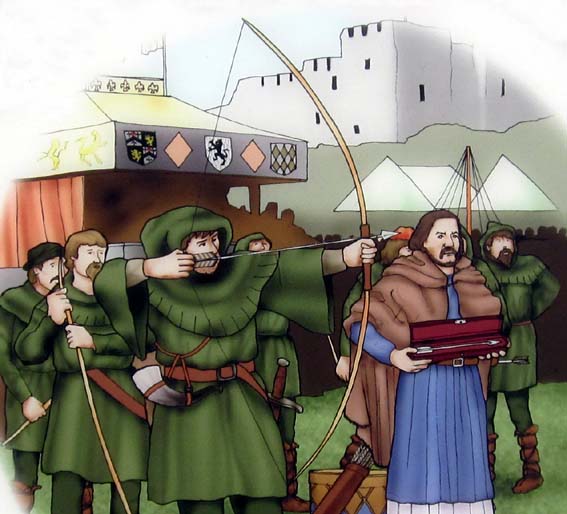 .
.
An artists impression of the 'silver arrow contest' as described in the ballad A Lyttell Geste of Robyn Hode.
There is no historical evidence that such a contest occurred although it may indicate a metaphorical statement.
Some
have suggested that 'Little John' of the Geste was
John the first son of William de Faucumberg of Catfoss manor
in Holderness. Henry de Faucumberg was William's second son.
The eldest brother John should have inherited the Catfoss estate
in Holderness, but for an unknown reason when the father,William,
died in January 1295, Henry took over the estate.
Lord William de Faucumberg=============Matilda de Goushill
of
Catfoss*, Holderness
|
b~1270
d 4th Feb 1295
_____________________________________________________________________
|
|
|
|
John de Faucumberg
Sir Henry de Faucumberg ===Elena de Hertford
William Lora=====Herbert
[found to be
an idiot 1295]+
Sheriff of Notts.& Derbs.
b. 1290
St. Quentin
and Yorks
Skelton of
Frome, Dorset
* Held of a distant
cousin of William's, Walter de Faucumberg of Skelton near
Goole and Rise.
+ Henry had
to pay his elder brother £20 per year until John's death
for the inheritance of Catfoss. This John
may be the model
for Little
John in the Geste.
It may be that John was declared mentally incompetent to inherit
[Phillips and Keatman p.87]. The name Henry Faucumberg appears
several times in the WCR, which shows that he gained a good sized
estate in Holderness.
When the sheriff of the Geste enquires
of Little John:
"Tell me now, young man,
What is your name?
In what country were you born,
Where abouts is your home?"
Little John replies:
"In Holderness, Sir I was born,
I was told by my mum,
Men call me Reynald Greenleaf
whenever I am at home."
Upon hearing this the audience would have
fallen about on the floor laughing at the comic irony. When
we know the inside story it is hilarious! The author is having
fun with his enemy. Henry Faucumberg's early career may have
been less than commendable, as tabled above, by 12th March 1313
in the WCR a person called Henry de Faucumberg was recorded as stealing
wood from the barn of John 8th earl Warrene, this barn may have resided
within Sandal Castle
itself. By the 4th of October he had received a fine for again stealing
wood and by 27 March he was recorded in the WCR for his refusal to take
an oath [contempt of court]. By now at least he was a recidivist for once
again on the 18th October 1315, he was fined for theft, but in a rapid
reversal of fortunes [if this person is the same as the man from Catfoss]
he was appointed, by 1318, as the Sheriff of Nottinghamshire and Derbyshire.
Again Faucumberg is in the opposing camp to the Le Waleys, for during
the first two decades of the 1300's he was a resident of the manor
of Wakefield whilst the Le Waleys were under the umbrella of the honour
of Pontefract.
In the Geste the sheriff is not named. Bellamy [1985] has
suggested that this was because the sheriffs of each county changed
office regularly, often every year. In 1323 the critical year, Ingram
was the sheriff until June 1st when he was succeeded by Henry de
Faucumberg.
Apart from Henry de Faucumberg, Gervase
Clifton 1st baronet was the only other man to serve both as
a sheriff of Yorkshire and Nottinghamshire within the period
1250-1350.[Phillips & Keatman p.86] Again, as Phillips and Keatman say without
suspecting the authorship of the Geste "Faucumberg
is easily the best candidate for the sheriff that the ballad writer
wished to target." [p.86]
Certainly, the author here agrees with
Phillips and Keatman that "....the composer of the Gest
based his story on historical events following the Lancastrian
revolt." But while Phillips and Keatman, like many others,
followed the road to try to identify who Robyn Hode
was, we are here following the road to identify the author of the
Geste. Instead of King John being the King who ruled
during the time of the 'Sheriff of Nottingham' in the Geste,
it is an equally detested king in some quarters, Edward II.
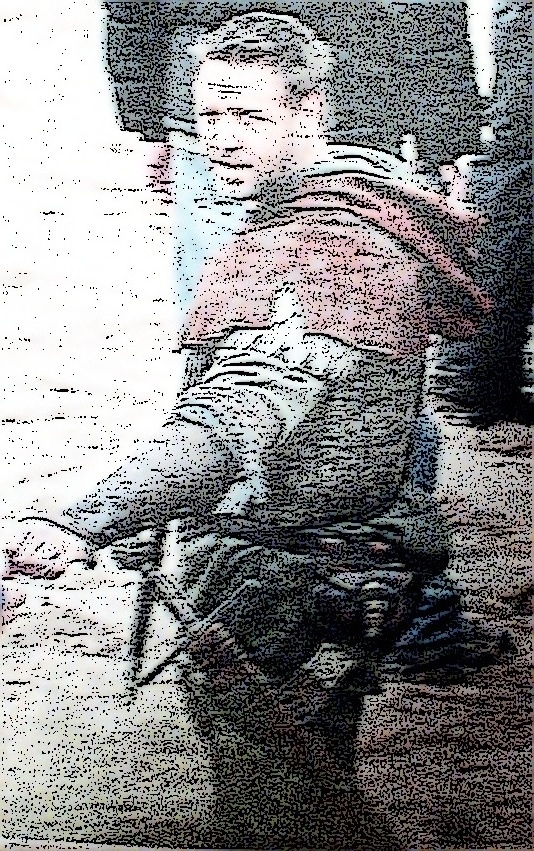
|
| The latest speculated attire of the ballad character, 'Robyn Hode'. A well-known actor played Robyn in a film in 2010. Once again it seems to be arbitrarily set in the 1100's-1200's and the part is not played by an English actor although there has been some attempt to give him a regional accent which sounds quasi-Midlands-Yorkshire. The problem is that the real inspiration for the ballad character did not have a Midlands or Yorkshire accent. One thing we can be sure of, the person upon whom the ballad character was based was certainly not Australian or American! The latest addition to the crop of 'Robin Hood' films appeared in cinemas in May 2010 but it distinguishes itself by being more violent than previous films of this genre. In this regard it may be closer to the reality existing in the medieval period while moving away from the intended jocular narrative of the ballad 'A Lyttell Geste of Robyn Hode'. |
Footnote:
Although Henry de Faucumberg at first appears to be equated with
the 'sheriff' in the Geste, and may in part be a conflation
with another, there is a far better identity who is undoubtedly an excellent
model for the reviled one. However, because I have found the Geste
to be highly allegorical, this identity will be a great surprise to
many.
Sources/References:
1. Bellamy, John. Robin
Hood: An Historical Enquiry, London, 1985.
2. Phillips G. & Keatman
M., Robin Hood, The Man Behind the Myth,
O'Mara, 1995.
3. Hunter, Joseph. The
Ballad Hero: Robin Hood, (The Yorkshire Antiquarian),
London, 1852.
4. Langdale,
Thomas. Yorkshire Sheriffs in The Yorkshire Dictionary,
1822.
5. Holt, J.C. Robin Hood.
Thames and Hudson 1982.
6. Harris, P.V. The Truth About Robin Hood,
Mansfield, 1973.
7. Bellamy, John. Robin Hood: An Historical Enquiry,
London, 1985 p. 39.
8. Harris. P.V. The Truth about Robin Hood. p. 79.
9. C.F.R. 1319-1327, p. 308.
10. C.F.R. 1319-1327, p. 309.
11. Foster, J. Feudal Coats of Arms. Repr. 1995, pp. 88-89, 90-91.
12.
C.P.R., 1313-1317, p.
314.
© Copyright Tim Midgley 2000, internal links revised July 2023.